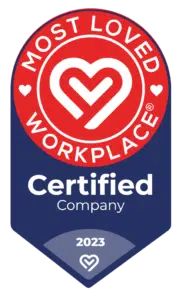How to Maintain a Strong Culture of a Most Loved Workplace During Periods of Change
6 min. Read
Change is inevitable in the business world today. Whether due to mergers, acquisitions, new leadership, or new corporate structures, organizations must navigate these changes while maintaining a strong company culture. This article explores best practices for maintaining a most-loved workplace’s strong culture during periods of change, focusing on company culture and change management strategies.
Table of Contents
Understanding the Impact of Change
Periods of change can have a significant impact on company culture. Employees may experience uncertainty, stress, and a need for clarity about their roles and responsibilities. As a result, employee engagement and morale can suffer, causing decreased productivity and increased turnover. Organizations need to address these challenges and maintain a positive workplace culture proactively.
During periods of change, clear communication is key to helping employees understand the reasons behind the changes and how they will be affected. Organizations should provide regular updates and opportunities for employees to ask questions and provide feedback. This transparency can help alleviate uncertainty and build trust within the organization.
Additionally, organizations should focus on supporting employees through change by offering resources and training to help them adapt to new roles or responsibilities. Providing coaching or mentoring programs can also be beneficial, as they can help employees navigate the changes and feel supported throughout the process. By investing in employees’ well-being during periods of change, organizations can maintain a strong and resilient company culture.

Building a Thriving Workplace Culture!
Discover how to leverage the right technology and implement a proactive strategy that cultivates talent and facilitates team collaboration.
Common Reasons for Periods of Change
Organizations experience periods of change for various reasons, often driven by external factors or internal decisions. These changes can profoundly impact the company’s culture, employee morale, and overall performance. Understanding the common reasons for these changes is crucial for organizations to navigate them effectively and maintain a strong culture of a Most Loved Workplace.
Mergers and Acquisitions
When two companies merge, or one company acquires another, the organizational structure and culture can significantly change. It can result in redundancies, changes in reporting lines, and the integration of different work cultures. Employees may feel uncertain about their future roles and responsibilities, leading to anxiety and decreased morale.
Additionally, mergers and acquisitions can create challenges related to communication and alignment. Different organizational cultures and values may clash, requiring careful navigation to ensure a smooth integration process. Leadership must provide clear communication and direction to alleviate issues and foster a sense of unity among employees from both entities.
New Leadership
Leadership changes can bring new strategies, priorities, and working methods, impacting the company culture. A new leader may have a different vision for the organization, leading to process changes, communication styles, and decision-making. Employees may need time to adjust to the new leadership style and direction, which can impact their engagement and motivation.
New Corporate Structures
Restructuring initiatives to improve efficiency or respond to market changes can also lead to periods of change. These initiatives may involve reorganizing departments, the introduction of new roles or responsibilities, and changes in reporting relationships. Employees may feel uncertain about how these changes will impact their jobs and future, leading to stress and decreased morale.
Other Reasons for Change
Other common reasons for periods of change include changes in market conditions, technological advancements, regulatory changes, and the need to remain competitive. These factors can require organizations to adapt quickly, leading to changes in processes, systems, and organizational structures. Employees may need support to navigate these changes and understand how they can contribute to the organization’s success during these challenging times.
Importance of Having One Employee Listening Platform
 Organizations must have one employee listening platform to collect and analyze employee feedback during a change. This platform should provide a unified view of employee sentiment and enable organizations to identify areas for improvement.
Organizations must have one employee listening platform to collect and analyze employee feedback during a change. This platform should provide a unified view of employee sentiment and enable organizations to identify areas for improvement.Having one employee listening platform during periods of change provides several key benefits. Firstly, it ensures that all feedback is collected and analyzed consistently, allowing organizations to compare data over time and track progress on initiatives.
Secondly, a unified platform helps identify trends and patterns across different departments or teams, enabling organizations to address systemic issues impacting employee engagement and morale.
Lastly, a centralized platform can streamline the feedback process, making it easier for employees to provide input and for leaders to take action based on the insights gained.
Leveraging Workplacely for Change Management
Workplacely is a platform that can help organizations maintain a strong culture during periods of change. It offers multiple surveys and can integrate with other surveys to provide a comprehensive view of employee sentiment. With Workplacely, organizations can easily collect and analyze employee feedback, identify improvement areas, and develop targeted action plans.
One of the key features of Workplacely is its ability to provide customized surveys that can help organizations get additional insights into their employees’ thoughts and feelings. By leveraging these surveys, organizations can better understand their employees’ needs and preferences, which can help them tailor their change management strategies accordingly.
Features and Benefits of Workplacely
Workplacely empowers employees by providing them a platform to voice their emotions and sentiments and coach themselves and their peers. It also equips leadership teams to take action by providing real-time insights and reducing survey fatigue.
The platform offers unprecedented insights with advanced AI tools, including a robust AI-driven recommendation engine and curated custom surveys. Workplacely helps organizations become the Most Loved Workplaces, which experience higher customer satisfaction, profitability, and lower turnover.
Moreover, Workplacely goes beyond traditional engagement surveys by measuring love, not just engagement. This unique approach allows business leaders to gauge employees’ affection and regard for their workplace, leaders, and peers. By focusing on love as a metric, organizations can better understand employees’ emotional connection with their work environment, leading to more meaningful actions and improvements.
You can learn more about Workplacely, its features and benefits, and how they can help your organization maintain a strong culture during periods of change here.
Final Word
Maintaining a strong culture of a Most Loved Workplace during periods of change requires a proactive approach to change management and a focus on company culture. Using tools like Workplacely, organizations can effectively navigate periods of change and ensure that their employees remain engaged and motivated.
Suppose you’re interested in learning more about how a Most Loved Workplace uses the Workplacely platform to benefit your organization, especially during periods of change. In that case, you can get in touch with us today.

Louis Carter is the founder and CEO of Best Practice Institute, Most Loved Workplace, and Results-Based Culture. Author of In Great Company, Change Champions Field Guide, and Best Practices in Talent Management, as well as a series of Leadership Development books. He is a trusted strategic advisor and coach to CEOs, CHROs, and leaders of mid-sized to F500 companies – enabling change and steering employer brand development together with highly effective teams, leaders, and organizations as a whole.



0 Comments